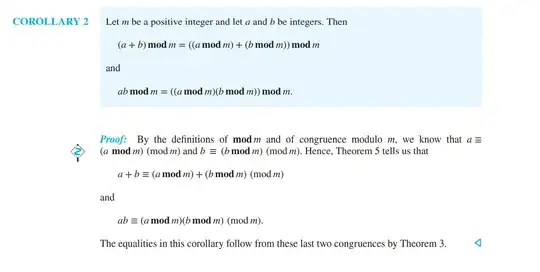SO basically I am learning number theory chapter in the Discrete Maths.
Now I really don't understand a proof here.
 SO basically it is a corollary which says
SO basically it is a corollary which says
Let m be a positive integer and let a and b be integers. Then
(a + b) mod m = ((a mod m) + (b mod m)) mod m
and
ab mod m = ((a mod m)(b mod m)) mod m.
Now the proof goes something like this.
Proof: By the definitions of mod m and of congruence modulo m, we know that a ≡
(a mod m) (mod m) and b ≡ (b mod m) (mod m). Hence, Theorem 5 tells us that
a + b ≡ (a mod m) + (b mod m) (mod m)
and
ab ≡ (a mod m)(b mod m) (mod m).
What i really can't get here is how is the
a ≡ (a mod m) (mod m) and b ≡ (b mod m) (mod m)
I know about the reflexive property about mod but how come this two mod. what i know is a ≡ (a mod m) but how they are saying a ≡ (a mod m) (mod m)